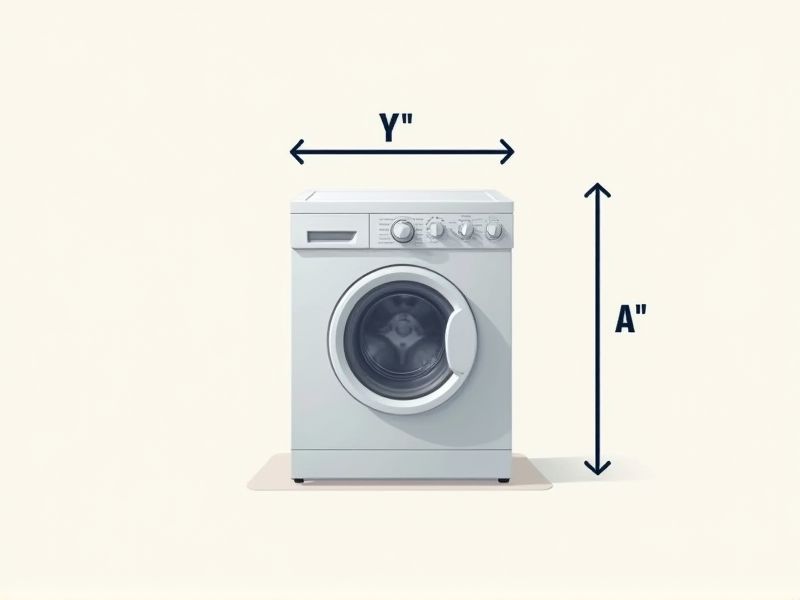
When selecting a washing machine, knowing the standard dimensions can help you plan for installation and ensure a proper fit in your laundry area. Most full-size, front-loading and top-loading washing machines typically measure around 27 inches wide, 38-40 inches tall, and 30-34 inches deep. Compact models are usually about 24 inches wide, 33 inches tall, and 24-26 inches deep, making them ideal for smaller spaces or apartments. Always double-check manufacturer specifications before purchase to ensure your chosen model fits your designated space and allows for proper ventilation.
Capacity Measurement
The capacity of washing machines is typically measured in cubic feet, with common options ranging from 3.5 to 5.5 cubic feet. A larger capacity allows you to wash more laundry in a single load, which can save time and energy. For instance, a 4.5 cubic foot washing machine can handle approximately 12-16 pounds of laundry, accommodating large items like comforters or bed linens. Choosing the right capacity based on your household's laundry needs can significantly enhance your washing efficiency.
Width Range
The width of washing machines typically ranges from 24 inches to 30 inches, catering to various consumer needs and space constraints. Compact models, usually around 24 inches, are ideal for small apartments or tight laundry areas, while standard models, generally 27 to 30 inches wide, provide larger capacities for families. Ensuring optimal width can enhance installation convenience and maximize laundry efficiency. When choosing your washing machine, consider the specific width that fits your available space to avoid complications during setup.
Height Range
The height range of standard washing machines typically varies between 33 to 36 inches, designed to accommodate users' ergonomic needs. This height ensures comfortable loading and unloading without straining your back. Models below 33 inches cater to compact spaces, while those exceeding 36 inches often feature advanced functionalities for modern households. Knowing the optimal height for your laundry room helps you make a well-informed purchase, enhancing efficiency in your daily routine.
Depth Range
The depth range of washing machines typically varies between 25 to 30 inches, with compact models designed for smaller spaces often measuring around 24 inches deep. This depth affects installation options, especially in tight laundry areas or closets. A deeper machine may offer larger capacity, accommodating up to 4.5 cubic feet or more, suitable for families with significant laundry demands. When selecting a washing machine, consider your available space alongside your laundry volume to ensure optimal functionality.
Drum Size
The standard drum size of washing machines typically ranges from 7 to 12 kilograms, catering to various household needs. A larger drum size allows for processing more laundry per cycle, significantly reducing the number of washes needed each week. For families or individuals with heavy laundry requirements, opting for a 10-12 kg drum can enhance efficiency and save time. In contrast, smaller households may find a 7-8 kg drum sufficient for their regular needs, striking a balance between capacity and energy consumption.
Door Size
When selecting a washing machine, the door size is a crucial factor impacting usability and convenience. A standard front-loading washing machine door typically measures between 22 and 30 inches in diameter, allowing easy access for loading and unloading laundry. You might find that a larger door not only improves accessibility but also accommodates bulky items like comforters or blankets without difficulty. Considering your laundry needs, opting for a washing machine with an appropriately sized door can significantly enhance your overall washing experience.
Installation Space Requirement
When selecting a washing machine, it's essential to consider the installation space requirement, which typically ranges from 24 to 30 inches in width for front-loading machines and 27 to 32 inches for top-load models. Ensure that there is at least one inch of clearance on all sides to facilitate proper air circulation and access for maintenance. A minimum vertical clearance of 32 inches is also recommended, particularly for top-loading machines that require a full lift to open the lid. Measure your available space accurately to avoid complications during installation and ensure efficient operation of your appliance.
Adjustability Options
Washing machines today offer a range of adjustable options to enhance user experience, with over 10 customizable wash cycles tailored for different fabric types and soil levels. Many models feature advanced load sensing technology, ensuring optimal water and energy usage based on the size of each load. You can also find machines with adjustable spin speeds, ranging from 400 to 1400 RPM, allowing for efficient drying without damaging delicate garments. The inclusion of temperature controls permits settings from cold to hot, catering to various cleaning needs and preferences.
Standardization Across Brands
The standardization of washing machines across brands often revolves around uniform performance metrics, such as energy efficiency ratings, which are typically measured in kilowatt-hours (kWh) per load. Most modern machines adhere to the Energy Star certification, indicating they consume at least 20% less energy than non-certified models. Additionally, you may find that the average wash time ranges from 30 to 60 minutes, depending on the selected cycle and load size. Size capacity is also standardized, with most residential machines offering between 3.5 to 5.0 cubic feet, accommodating varying laundry needs.
Impact On Load Size
The standard capacity for most residential washing machines ranges from 3.5 to 5.0 cubic feet, directly influencing the load size you can effectively wash. Larger machines, typically above 4.5 cubic feet, accommodate bulky items like comforters and blankets, which is ideal for households with multiple members. Many models offer load sensing technology that automatically adjusts water levels according to the load size, maximizing efficiency and reducing water waste. It's essential to consider both the capacity and your typical laundry needs to select a washing machine that optimizes your laundry experience.
